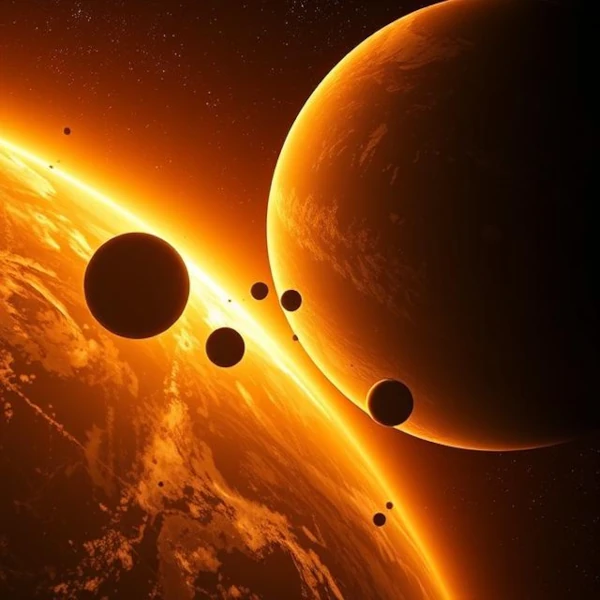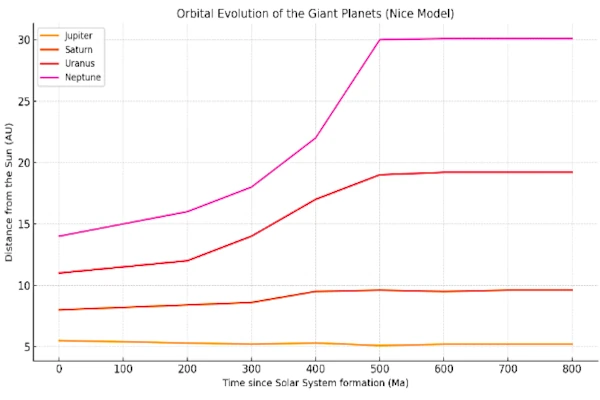
At the beginning of the 21st century, a group of astrophysicists from the Observatory of the Côte d'Azur in Nice proposed a revolutionary scenario to explain the current distribution of the planets, the structure of the asteroid belt, and the origin of the late heavy bombardment (LHB): the Nice model.
This model postulates that after the dissipation of the protosolar gas disk, the giant planets (Jupiter, Saturn, Uranus, Neptune) migrated due to gravitational interactions with a vast population of small icy bodies, initially confined beyond Neptune's orbit.
In the initial version of the Nice model, the giant planets did not occupy the positions they have today. They were closer to each other, forming a compact and almost circular structure. Jupiter, Saturn, Uranus, and Neptune evolved in slightly eccentric orbits, with respective orbital radii of about 5.5 AU, 8 AU, 11 AU, and 14 AU from the Sun. This system was initially stable, without major cross-interactions.
At that time, a massive disk of small bodies (icy planetesimals) extended beyond Neptune's orbit, between 15 and 35 astronomical units. This disk contained up to 30 Earth masses of material, representing a major dynamic source for gravitational interactions with the outer planets.
Although seemingly stable, this configuration contained the seeds of instability. The slow but continuous gravitational interactions between the planets and the planetesimals gradually modified the orbital parameters of the planets. When Jupiter and Saturn approached an orbital resonance (2:1), a brutal reorganization began, initiating planetary migration and the events that followed. This slow orbital coupling would lead to a sudden dynamic shift: the planetary instability triggered by a mutual resonance.
This initial phase, which precedes the orbital upheaval, is crucial for understanding the subsequent events: planetary migration, the diffusion of small bodies, and the late heavy bombardment.

When Jupiter and Saturn reach a 2:1 orbital resonance (the ratio of their periods becomes 2 to 1), a major gravitational instability is triggered. This configuration strongly disrupts the orbits of Uranus and Neptune, which are then projected outwards. They cross the belt of planetesimals, causing the dispersion of billions of icy objects throughout the inner and outer Solar System.
This sudden displacement would have led to a period of massive collisions on the terrestrial planets, particularly the Moon, Mars, and Earth, about 700 million years after the formation of the Solar System. This phase, identified through radiometric dating of lunar rocks brought back by the Apollo missions, is known as the late heavy bombardment, dated around 3.9 billion years ago.
It is notably correlated with the creation of many lunar impact basins such as Imbrium or Orientale. This phenomenon could also have contributed to the late delivery of water and organic matter to Earth.
Since its initial formulation in 2005, the Nice model has been refined (Nice II, Nice III) to integrate effects such as the gravitational friction of the residual gas disk, interactions between massive planetesimals, or the hypothesis of a fifth giant planet ejected.
Numerical simulations, correlated with observations of trans-Neptunian objects (TNOs), confirm the effectiveness of the model in explaining the eccentric and inclined orbits of many small planets, such as Sedna or Eris.
| Phenomenon | Observed consequence | Geological or orbital evidence | Source |
|---|---|---|---|
| Jupiter-Saturn resonance | Gravitational instability | Numerical model (res. 2:1) | Morbidelli et al., 2005 |
| Migration of Uranus and Neptune | Rearrangement of the Kuiper Belt | Orbital distribution of TNOs | Levison et al., 2008 |
| Dispersion of planetesimals | Late Heavy Bombardment | Dating of lunar rocks | Tera et al., 1974 |
| Possible planetary ejection | Instability reduced to 4 giants | Numerical simulations | Nesvorný, 2011 |
| Capture of Trojan asteroids | Presence of co-orbital objects of Jupiter | L4 and L5 populations (asymmetries, sizes) | Morbidelli et al., 2005 |
| Inclination of trans-Neptunian disk objects | Eccentric and inclined orbits | TNOs with high inclinations and perihelia | Gomes et al., 2005 |
| Restructuring of the asteroid belt | Depletion and orbital excitation | Current low total mass | Minton & Malhotra, 2009 |
| Stabilization of the inner solar system | Final alignment of planetary orbits | Current stable architecture | Tsiganis et al., 2005 |
References: Morbidelli et al., Nature, 2005, Levison et al., Icarus, 2008, Tera et al., Science, 1974, Nesvorný, ApJ, 2011.